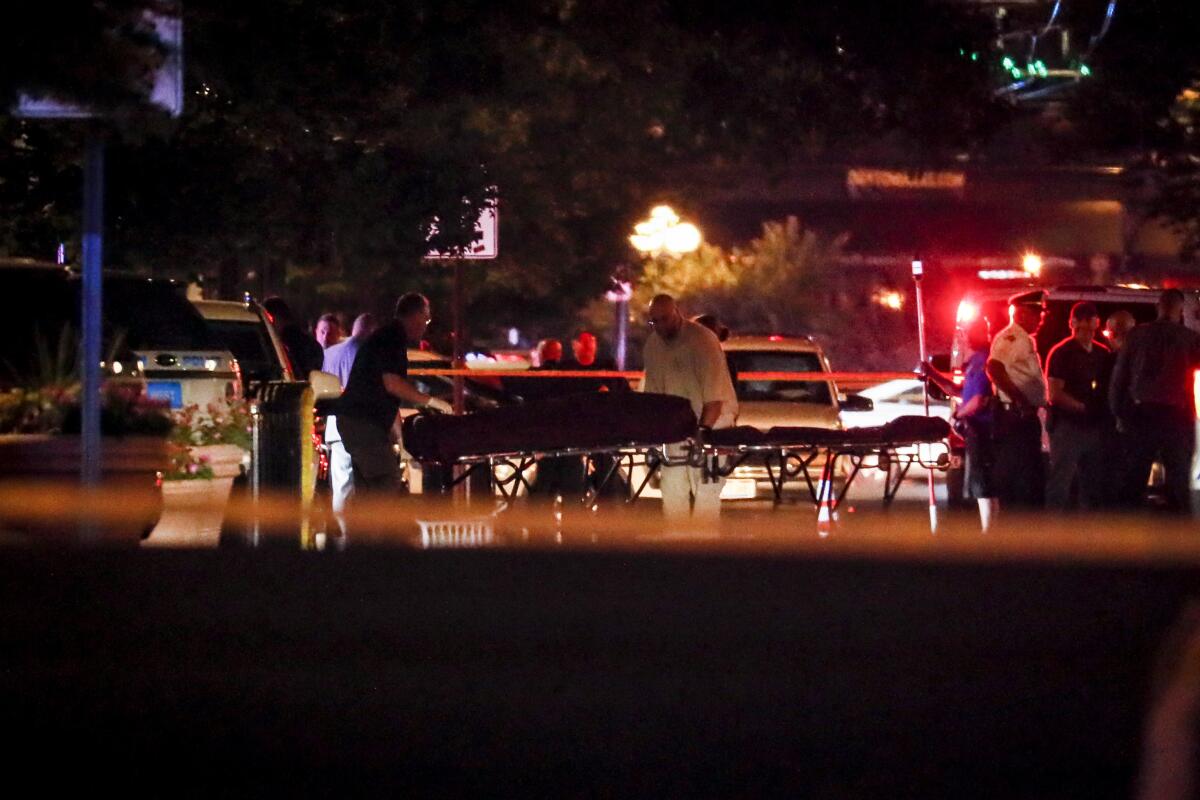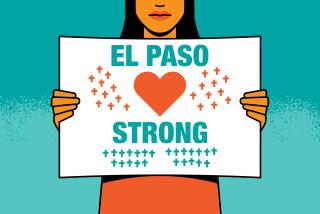Two days, two mass shootings in El Paso and Dayton, Ohio – just another weekend in America

- Share via
It’s curious that in response to mass violence so many people struggle to find ways to put on a brave face, or to deflect the real issues.
In Dayton, Ohio, a common refrain this morning is that it could have been worse. A masked man in body armor carrying large-capacity magazines opened fire with a .223 caliber rifle on unsuspecting late-night partiers in a bar district, killing at least nine and wounding an additional two dozen or so. Because it is a popular nighttime gathering place, Dayton police conduct regular patrols and officers confronted and shot the gunman dead within a minute or so, officials said.
So yes, it could have been worse. The police could have been a few blocks farther away. The gunman could have been more efficient in wielding his rifle — make and style still unknown but we all know what kind of gun it was — and the body count could have been much higher.
That misses the point: There shouldn’t have been a body count at all.
In El Paso, the site of the previous outrageous attack some 12 hours earlier, local officials have pointed out that the alleged gunman who killed 20 people — 20! — and injured more than two dozen others was, in fact, a stranger in town, someone from away. As though that makes a difference to the dead and the wounded. As if Allen, Texas, where the suspected gunman lived, and El Paso are fundamentally somehow different. Are there currents of venality that course through one part of Texas and not another? One part of America and not another?
The gunman in Gilroy — three were killed there — was, in fact, a local and “very much a loner,” a neighbor says. It’s not yet known where the Dayton gunman hails from but it’s a good bet that his driver’s license lists an address somewhere in the general area.
In Virginia Beach, Va., in May, a man who had just resigned from his job in the city Public Utilities department shot up the office, killing 12. In February, another worker opened fire on his former colleagues in Aurora, Ill., killing five. In November, a former Marine shot up the Borderline Bar & Grill in Thousand Oaks, killing a dozen people out for a night of country line dancing.
All local perpetrators. All men. All using firearms.
These aren’t strangers in our midst. These aren’t adherents to radical religious beliefs from the other side of the world. These aren’t agents of a foreign power.
This is us, killing us, with numbing regularity and in disgustingly high numbers.
Politicians, meanwhile, were falling over each other Sunday morning to get camera time on the cable news shows to express their shock and grief. Who can be shocked any more?
What should be shocking us is our political inaction in the case of relentless gun violence. These mass murders grab us by the collective collar and force us to confront the ugliness within society, the sickness within individuals, the cost of deferring to the gun lobby’s ludicrous control over gun laws.
Yet we change nothing.
As traumatic as these mass killings might be, they are just the dramatic tip of the iceberg. So far this year — and the weekend is not yet over — the Gun Violence Archive has recorded more than 8,734 people shot to death and more than 17,300 people wounded or otherwise injured in more than 33,000 incidents. And that doesn’t include firearm suicides, which occur far more often than homicides or accidental shooting deaths.
It’s a safe bet that few of those 33,000 shooters were from “away.”
Here are two tangential elements of this weekend’s mass murders. One of the highest-grossing movies of the weekend is “Once Upon a Time ... in Hollywood,” a Quentin Tarantino movie that ends in brutal violence. This isn’t to argue that Hollywood violence begets real world violence. When it comes to movies, art follows life, and a violent nation that turns to depictions of violence for entertainment is in dire need of a psychiatrist.
The second twist is that the killings in Dayton — a man with a motive, a deadly firearm, lots of ammunition and a crowded street — occurred just yards from a local bar that makes its own beer. The name? Toxic Brew.
These days, that says more about our country than “E Pluribus Unum.”
More to Read
A cure for the common opinion
Get thought-provoking perspectives with our weekly newsletter.
You may occasionally receive promotional content from the Los Angeles Times.










